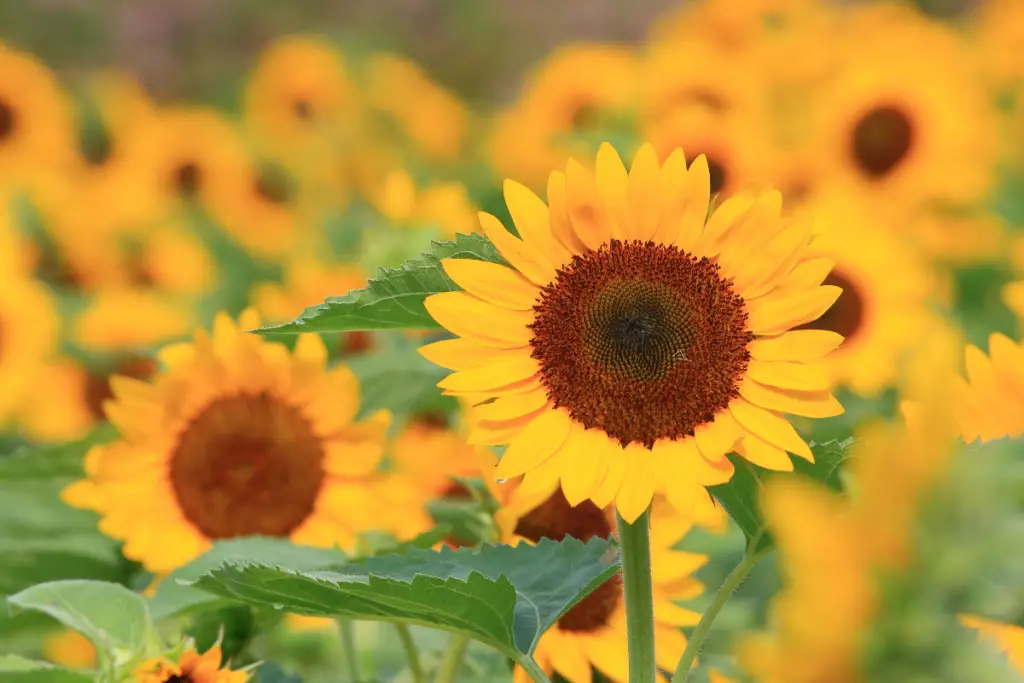Sunflowers are known for their bright yellow petals and towering height, making them a popular choice for gardens and fields alike.
But when it comes to planting sunflower seeds, what is the ideal depth?
This is a question that many gardeners and farmers may have, as the depth at which sunflower seeds are planted can have a significant impact on their growth and development.
According to gardening experts, the ideal depth for planting sunflower seeds varies depending on the size of the seed.
Most sunflower seeds should be planted about 1/2 inch to 1 inch deep, although some varieties may require deeper planting.
Planting seeds too shallow can result in poor germination, while planting them too deep can cause them to struggle to break through the soil and reach the surface.
It is important to note that sunflower roots are sensitive to being moved, so transplanting them may kill them, making it crucial to plant them at the correct depth from the start.
Whether you’re a seasoned gardener or just starting out, understanding the ideal depth for planting sunflower seeds is key to achieving healthy, vibrant plants.
By taking the time to plant your seeds at the correct depth, you can help ensure that they have the best possible chance of thriving and producing beautiful blooms.

Table of Contents
Understanding Sunflower Seeds
Sunflowers are known for their bright yellow petals and their ability to turn towards the sun. They are also popular for their edible seeds and oil.
Planting sunflower seeds is a fun and easy way to add some color and life to your garden or yard.
Here is what you need to know about sunflower seeds:
Seed Size and Type
Sunflower seeds come in different sizes and types. Some seeds are larger and easier to handle, while others are smaller and require more precision when planting.
The size of the seed also affects the depth at which it should be planted.
Planting Depth
Most sunflower seeds should be planted about 1/2 inch to 1 inch deep, although some varieties may require deeper planting.
Planting too shallow can result in the seed drying out, while planting too deep can prevent the seed from germinating.
Germination Time
Sunflower seeds typically germinate within 7 to 14 days after planting. The optimal temperature for germination is between 70°F and 85°F.
Soil Requirements
Sunflowers grow best in well-draining soil with a pH between 6.0 and 7.5. The soil should be loose and free of debris to allow for proper root growth.
Watering
Sunflowers require regular watering, especially during the germination period. The soil should be kept moist but not waterlogged. Once the plant is established, it can tolerate some drought.
Sunlight
Sunflowers require full sun to grow and thrive. They should be planted in an area with at least 6 hours of direct sunlight per day.
Companion Planting
Sunflowers can be planted with other plants, such as beans, peas, and corn. They can also attract beneficial insects, such as bees and ladybugs, to your garden.
Overall, planting sunflower seeds is a fun and rewarding experience. With the right planting depth, soil, watering, and sunlight, you can grow beautiful sunflowers in your garden or yard.
Ideal Depth for Planting Sunflower Seeds
Sunflowers are a popular garden plant that can add a bright splash of color to any landscape.
However, planting them at the right depth is crucial to ensure they grow healthy and strong.
The ideal depth for planting sunflower seeds depends on several factors, including the size of the seed and the type of soil.
Factors Determining Ideal Depth
The size of the sunflower seed is one of the primary factors determining the ideal planting depth.
Most sunflower seeds should be planted at a depth of about 1/2 inch, but some larger seeds may need to be planted up to 1 inch deep.
It’s important to check the specific instructions on the seed packet, as some varieties may require differing depths.
Another important factor to consider is the type of soil. If the soil dries out quickly, it’s best to plant the seeds a little deeper to ensure they have enough moisture to germinate.
On the other hand, if the soil is heavy and compacted, planting the seeds too deep can make it difficult for the young seedlings to break through the surface.
Impact of Planting Depth on Growth
Planting sunflower seeds at the right depth is crucial to ensure they grow strong and healthy.
If the seeds are planted too shallow, they may not have enough moisture to germinate, and the young seedlings may dry out and die.
On the other hand, if the seeds are planted too deep, it can take longer for the seedlings to emerge, and they may not have enough energy to push through the soil.
Planting sunflower seeds at the ideal depth can also affect the growth and development of the plant.
If the seeds are planted too shallow, the roots may not be able to anchor the plant securely in the soil, making it more susceptible to wind damage.
On the other hand, if the seeds are planted too deep, the young seedlings may not have enough energy to develop a strong stem, which can lead to stunted growth and poor yields.
In conclusion, planting sunflower seeds at the right depth is crucial to ensure they grow healthy and strong.
By considering the size of the seed and the type of soil, gardeners can determine the ideal planting depth for their sunflowers.
Methods for Planting Sunflower Seeds
When it comes to planting sunflower seeds, there are two main methods: hand planting and using seed planters.
Hand Planting
Hand planting is a simple and straightforward method that involves manually placing each seed into the soil.
This method is ideal for small-scale planting, such as in a home garden or a small farm.
To hand plant sunflower seeds, follow these steps:
- Prepare the soil by loosening it to a depth of at least 6-8 inches and removing any rocks or debris.
- Dig a small hole in the soil using a trowel or your fingers. The ideal depth for planting sunflower seeds is 1/2 inch to 1 inch, depending on the variety.
- Drop a single seed into the hole and cover it with soil.
- Space the seeds at least 6 inches apart to allow room for the plants to grow.
Using Seed Planters
Seed planters are mechanical devices that can help speed up the planting process and ensure that seeds are planted at a consistent depth and spacing.
They are ideal for larger-scale planting, such as on a commercial farm.
To use a seed planter, follow these steps:
- Prepare the soil as you would for hand planting.
- Adjust the seed planter according to the seed size and planting depth recommended by the manufacturer.
- Fill the seed planter with sunflower seeds.
- Push the seed planter along the soil, releasing the seeds as you go. The planter will automatically place the seeds at the correct depth and spacing.
- Once all the seeds have been planted, lightly water the soil to help the seeds germinate.
While seed planters can be a useful tool for planting sunflower seeds, they can be expensive and may not be necessary for smaller-scale planting.
Hand planting can be just as effective and is a more cost-effective option for many growers.
Common Mistakes While Planting Sunflower Seeds
Planting sunflower seeds may seem like an easy task, but there are some common mistakes that can ruin your crop.
Here are some of the most common mistakes people make while planting sunflower seeds:
Planting Without Enough Sun
Sunflowers need plenty of sunlight to grow properly. Planting them in a shaded area can lead to stunted growth, fewer blooms, and weaker stems.
Make sure to choose a sunny spot with at least 6 to 8 hours of direct sunlight per day for your sunflowers to thrive.
Planting Too Early or Too Late
Planting sunflower seeds too early in the season, before the last frost, can result in the seeds rotting or the seedlings dying due to the cold temperatures.
On the other hand, planting sunflowers too late in the season can result in the plants not having enough time to mature and produce flowers before the first frost.
It’s best to plant sunflower seeds after the last frost has passed and the soil temperature has reached at least 55°F (13°C).
Planting Too Deep or Too Shallow
Planting sunflower seeds too deep or too shallow can also affect their growth. Sunflower seeds should be planted at a depth of about 1 inch (2.5 cm) in loose, well-draining soil.
Planting them too shallow can expose them to birds and other animals, while planting them too deep can prevent them from germinating properly.
Overcrowding
Planting sunflower seeds too close together can lead to overcrowding, which can result in competition for nutrients, water, and sunlight.
This can lead to weaker, smaller plants and fewer blooms. Make sure to space your sunflower seeds at least 6 inches (15 cm) apart to give them enough room to grow.
By avoiding these common mistakes, you can ensure that your sunflowers grow healthy and strong, providing you with beautiful blooms to enjoy.
Conclusion
In conclusion, the ideal depth for planting sunflower seeds is about 1/2 inch deep, and potentially down to 1 inch deep for varieties with larger seeds or in soil that dries out quickly.
However, it’s important to check the specific instructions on the seed packet, as some varieties may require differing depths.
Direct seeding is the most common method of planting sunflower seeds. Plant sunflower seeds 1 to 2 inches deep after the last threat of frost.
Space seeds 6 inches apart for smaller varieties and 12 inches apart for taller varieties. Once seedlings emerge, be sure to thin out as needed. Rows need to be spaced 2 to 3 feet apart.
Sunflowers are a versatile plant that can be grown for a variety of uses, including oilseed for vegetable oil production, nonoilseed for human food and bird food markets, and Conoil, which can be used for the dehull confection, oil or bird food markets.
The oilseed hybrids may be of three fatty acid types: linoleic, mid-oleic (NuSun) or high oleic.
With proper care and attention, sunflowers can grow to impressive heights of up to two meters and come in a wide range of colors including rusty red, orange, green, and even white.
The best time to plant sunflower seeds is in the spring after the last frost has passed.
Overall, planting sunflower seeds is a straightforward process that can yield impressive results with a little bit of attention and care.
By following the recommended planting depth and spacing guidelines, gardeners can enjoy a bountiful harvest of these beautiful and versatile flowers.
- How to Dry Basil Leaves: A Professional Guide
- Is an Avocado a Fruit or Vegetable? Simple Answer and Explanation
- Does Pineapple Have Seeds? Exploring the Anatomy of Pineapples
- Blooming Through Winter: Can I Grow Vegetables Indoors in the Winter?
- What Can You Grow in a Greenhouse All Year Round: A Guide to Year-Round Greenhouse Gardening
- Are Blueberries Blue? Debunking the Myth of Their Color
















